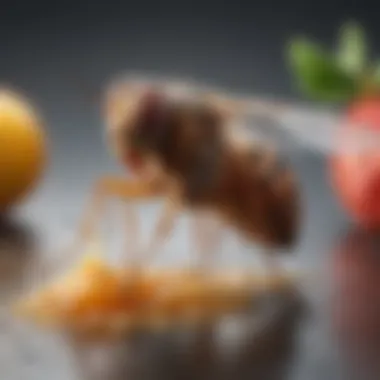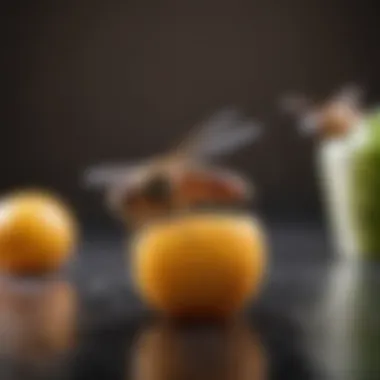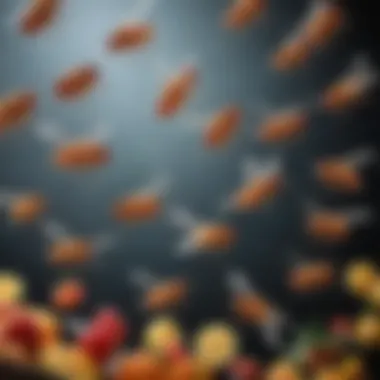What Repels Fruit Flies: Effective Prevention Strategies


Intro
Fruit flies are more than just a nuisance. They invade our kitchens, drawn in by the scent of ripe and rotting fruits. Understanding how to repel them effectively is essential for maintaining a clean and enjoyable cooking environment. This article delves into the behavioral patterns of fruit flies, discusses environmental factors contributing to their presence, and offers practical solutions that can be easily incorporated into any household routine. By exploring the nature of these pests, we gain insights that empower us to create spaces that are unwelcoming to fruit flies.
The following sections will highlight the key points about what attracts fruit flies, the sanitation practices necessary to deter them, and innovative traps that provide effective measures against their incessant presence. This resource serves casual cooks and culinary enthusiasts alike, enhancing the cooking experience by minimizing unwanted distractions.
Understanding Fruit Flies
Understanding fruit flies is fundamental when seeking strategies to keep them at bay. These insects are not just mere nuisances; they can compromise the hygiene of kitchens and food preparation areas. Knowledge about their biology and behavior allows us to implement effective prevention measures tailored to disrupt their life cycle and limit their attraction to environments where food is present.
Benefits of Comprehending Fruit Flies
By delving into the specifics of fruit fly biology and habits, individuals can become more adept at recognizing the signs of infestation early. This can lead to quicker interventions before a small problem escalates into a larger issue. Also, knowing what attracts them helps in tailoring sanitation practices to thwart their presence, ensuring kitchens remain a pleasant space for cooking and entertaining.
Biology of Fruit Flies
Fruit flies, scientifically known as Drosophila melanogaster, exhibit interesting biological traits that define their existence. Adult fruit flies are small, usually measuring about 1/8 inch in length. They are characterized by their tan bodies and red eyes, but variations exist. A remarkable feature is their rapid reproductive capability.
- Reproductive Capacity: A female can lay up to 500 eggs in her lifetime, often in or near fermenting or decaying fruit.
- Lifespan: The lifespan of fruit flies is relatively short, generally lasting about 15 to 30 days. However, during this period, they can multiply significantly, thereby complicating management efforts.
- Diet: They are primarily attracted to the scent of ripe or rotting fruit, as well as other organic materials like vegetables and fermented products.
Understanding their biology is crucial for employing effective strategies to repel them.
Life Cycle and Breeding Habits
Fruit flies undergo a four-stage life cycle: egg, larva, pupa, and adult. Each stage lasts a different amount of time and presents unique challenges for pest management.
- Egg Stage: The female lays eggs on decaying or overripe fruits. After approximately 24 hours, these eggs hatch into larvae.
- Larval Stage: The larvae feed on the fruit, growing rapidly within a few days.
- Pupal Stage: After about a week, the larvae develop into pupae, which are often found in moist areas.
- Adult Stage: Adult flies emerge from the pupae, starting the cycle anew.
This swift cycle enables fruit flies to become a significant pest in just a few weeks, illustrating the need for proactive measures to disrupt their breeding habitats. By monitoring and maintaining cleanliness, we can effectively limit their life cycle's stages, keeping infestations manageable.
Effective management of fruit flies is rooted in clear understanding of their biology and lifecycle.
Maintaining a keen awareness of these factors empowers individuals to stay one step ahead of fruit flies, ultimately creating an environment where these pests find little to entice them.
Factors that Attract Fruit Flies
Understanding the factors that attract fruit flies is crucial to implementing prevention strategies effectively. Identifying these elements allows us to take targeted actions that decrease their likelihood of intrusion. A proactive approach to managing these attractants is essential in maintaining a fruit fly-free environment, especially in kitchens where food is regularly prepared and consumed.
Role of Overripe Fruits
Overripe fruits play a significant role in attracting fruit flies. As fruits ripen, they emit specific volatile compounds that appeal to these pests. This scent often signals a food source to them, making any area with sitting fruit a prime target. A single overripe banana can emit enough cues to draw them in from the outside.
To reduce attraction from fruits, it is advisable to regularly inspect produce and remove any overripe items promptly. Keeping fruits in sealed containers or in the refrigerator can also help minimize their exposure and scent dispersal in the kitchen.
Significance of Decaying Organic Matter
Decaying organic matter is another major factor in fruit fly attraction. Areas that harbor decomposing fruits, vegetables, or even residual food matter become hotspots for insect activity. The decay process releases gases and odors that are particularly appealing to fruit flies.
It is not just food waste that can contribute to this issue; compost piles or litter bins can also perform this function. Proper disposal of organic materials in secured bags and maintaining cleanliness in compost areas is vital. This will ensure that decaying matter does not serve as an open invitation for fruit flies.
Impacts of Wet and Sticky Surfaces


Wet and sticky surfaces are commonly overlooked but contribute significantly to fruit fly attraction. Moist areas provide an ideal breeding ground for these pests. Any spills, particularly involving sugary substances, can quickly draw fruit flies in.
To mitigate this, it is essential to keep kitchen surfaces clean and dry. Items like spilled juices or remnants of food waste on counters and floors must be thoroughly cleaned. Regular cleaning routines can ensure that there are no lingering residues that might attract fruit flies, contributing to a more hygienic space.
The combination of cleanliness, timely waste disposal, and vigilant monitoring of food items plays a crucial role in minimizing fruit fly attraction.
By knowing these factors, it becomes possible to implement effective strategies against fruit flies, creating an inhospitable environment for their presence.
Sanitation Practices
Sanitation practices play a crucial role in repelling fruit flies. These small pests thrive in environments rich in food sources and organic matter. Maintaining cleanliness in the home can significantly decrease their presence. Fruit flies are attracted to rotting or overripe fruits, and poor sanitation only exacerbates the problem. Implementing effective sanitation measures contributes to a healthier home and prevents these unsightly insects from taking over.
Importance of Cleanliness
Here, cleanliness is more than just a matter of aesthetics. Regular cleaning eliminates potential breeding grounds for fruit flies, which are often found in kitchens and areas where food is prepared or stored. This involves not only routine sweeping and mopping but also addressing hidden spaces like behind appliances or inside cabinets.
Consider the following benefits of maintaining a clean environment:
- Prevention of infestations: Regular cleaning disrupts the life cycle of fruit flies.
- Enhanced hygiene: A clean kitchen reduces the risk of bacteria and mold, promoting a healthier living space.
- Better food preservation: Clean surfaces prevent contamination of food items, ensuring they remain fresh.
Adopting a systematic approach to cleaning—weekly deep cleans, daily tidying—will make a notable difference in the presence of fruit flies.
Effective Waste Management
Proper waste management is essential for minimizing fruit fly attractants. Proper disposal of food scraps and maintaining garbage containers is key. Fruit flies lay their eggs in decaying organic material, and any waste left out can encourage their proliferation. Here are some recommendations for effective waste management:
- Use sealed containers: Ensure all food waste is placed in containers with tight-fitting lids to make it inaccessible to fruit flies.
- Regular disposal: Take out the trash frequently, especially if it contains food waste.
- Composting considerations: If composting, use airtight systems to avoid attracting pests.
By eliminating food sources, you can help dismantle fruit fly populations before they become a serious concern.
Proper Food Storage Techniques
Storing food correctly is also a preventative measure against fruit flies. Improperly stored food items create appealing habitats for these pests. Here are some effective food storage practices:
- Refrigerate fruits and vegetables: Storing ripe fruits in the fridge slows down decay and reduces attraction.
- Seal containers: Use airtight containers for not just perishable goods but also dried products. This makes them less inviting to fruit flies.
- Label goods: Keeping track of expiration dates helps in staying organized and consuming food before it spoils.
"By implementing effective sanitation practices, we can make our kitchens inhospitable to fruit flies and enjoy a more pleasant cooking environment."
Natural Deterrents
Natural deterrents play a crucial role in creating an unfavorable setting for fruit flies. Unlike synthetic pesticides, these methods are often safer for both humans and the environment. Understanding their effectiveness enhances our capability to manage these pests. When fruit flies invade our spaces, their attraction to decomposing food and organic material becomes a major concern. Employing natural deterrents addresses this problem by leveraging commonly found substances that fruit flies find repugnant. Moreover, they often coexist well with our culinary practices rather than disrupt them.
Essential Oils as Repellents
Essential oils have gained attention for their ability to repel fruit flies effectively. Oils such as peppermint, lemongrass, and lavender contain compounds that emit strong scents. This particular characteristic makes them unappealing to fruit flies.
- Usage: To utilize essential oils, mix a few drops with water in a spray bottle and apply it around areas where fruit flies are likely to gather. Typical spots include countertops, trash bins, and fruit storage areas.
- Benefits: Besides deterring pests, these oils contribute pleasant aromas to the kitchen. They do not involve harsh chemicals, making them favorable for households with children or pets.
- Considerations: Always test a small area first as some surfaces may react to oils. Also, remember that essential oils evaporate, requiring regular reapplication.
Vinegar as a Deterrent


Vinegar is another powerful natural deterrent against fruit flies, specifically apple cider vinegar. Its pungent smell is often repulsive to these insects. It serves dual purposes: it can deter fruit flies while also being a useful cleaning agent.
- Application: To use vinegar effectively, create a trap by filling a bowl with apple cider vinegar and covering it with plastic wrap. Poke small holes in the wrap so that the fruit flies can enter but cannot easily escape.
- Advantages: This method not only catches existing flies but also prevents further infestation. Since it utilizes a completely natural product, it remains food-safe, making it ideal for culinary environments.
- Precautions: Ensure that the vinegar trap is placed strategically away from food prep areas to avoid any contamination risk.
"Natural deterrents provide a balance of safety and effectiveness, crucial in any fruit fly prevention strategy."
Commercial Solutions
Commercial solutions to repelling fruit flies play a critical role in maintaining a pest-free environment, especially in kitchens. Understanding these options can help in selecting the most effective strategies for fruit fly control. These solutions can complement sanitation practices, creating a multi-faceted approach to prevention.
Insect traps and baits are among the most popular commercial options available. They provide targeted intervention, specifically designed to attract and capture fruit flies. The effectiveness of traps lies in their ability to utilize various lures, which can include scents mimicking decaying fruit or other attractive substances. This makes them particularly useful for monitoring infestations and managing populations without resorting to harsher chemicals.
On the other hand, chemical repellents present another avenue to consider. While they promise to deter unwanted pests, one must weigh their potential health risks and environmental impact against their benefits. A careful assessment can guide your decision on whether these chemicals are a feasible part of your strategy.
Adopting commercial solutions can bring quick relief and ongoing protection. However, they should not be relied upon in isolation. An integrated approach will ensure both effectiveness and long-term results in fruit fly prevention.
Insect Traps and Baits
Insect traps and baits function through principles of attraction. These devices often utilize specific pheromones or food scents to lure fruit flies into catchment areas. They can come in various forms, including sticky traps, bait traps, and electrical traps, each having its advantages.
To maximize effectiveness, placement of these traps is essential. Here are some tips:
- Position traps near food sources: Place them close to potential breeding sites, such as fruit bowls or waste bins.
- Monitor the traps regularly: This allows for timely disposal of captured flies and repositioning traps as necessary.
- Choose the right type: Evaluate what works best for your particular environment, whether it's a sticky strip or a trap with a bait solution.
"Regular monitoring of traps provides insights into the severity of an infestation and allows for timely remediation."
Using these traps not only significantly reduces the fly population but can also serve as an early warning system for potential infestations.
Chemical Repellents: Are They Worth It?
Chemical repellents are designed to disrupt the flying behavior of fruit flies. Available in various forms such as sprays or granules, they might offer immediate relief. However, they come with numerous considerations.
When evaluating their use:
- Effectiveness: Different products vary in efficacy. Researching user reviews and professional reports can help find the most reliable repellents.
- Health considerations: Assess any potential health risks associated with the repellent, ensuring they are suitable for home use.
- Environmental impact: Many chemical options can be harmful to pets and the environment. Choose eco-friendly versions whenever feasible.
Habitat Modification Techniques
Habitat modification is a crucial aspect of preventing fruit flies in your environment. By altering the surroundings that attract these pests, you create a setting that is less inviting for them. This changes the overall appeal of your home or food-preparation area. The primary objective here is to make it difficult for fruit flies to thrive and reproduce.
When considering modifications, focus on specific areas that may need attention. It's essential to assess where these flies can find food, moisture, and entry points. By reducing these resources, you limit their chances of survival.
Reducing Standing Water
Standing water is one of the primary attractants for fruit flies. They often breed in stagnant environments, making it vital to eliminate sources of water. Check for clogged sinks, leaky faucets, or damp spots.
Here are effective steps to take:
- Inspect areas regularly: Check under sinks, in bathrooms, or near any appliances that may leak.
- Repair leaks promptly: Fix any dripping taps or pipes. Delaying repairs can lead to significant water accumulation.
- Avoid leaving dishes in water: Wash your dishes promptly after use. Soaking them can create a breeding ground for these pests.


By implementing these measures, you reduce moisture levels, disrupting fruit fly life cycles.
Screening and Sealing Entry Points
Another significant strategy is to screen and seal entry points. Fruit flies can easily enter homes through cracks and openings. By ensuring that your environment is well-sealed, you limit their access significantly. The most effective methods include:
- Install screens on windows and doors: Ensure that all windows have tight-fitting screens. This helps prevent flies from entering when open for fresh air.
- Seal cracks and gaps: Use weather stripping or caulk to seal any cracks in doors or around windows. Even small openings can provide a pathway for fruit flies.
- Use door sweeps: Adding sweeps to the bottom of doors can prevent flies from sneaking inside.
Taking these steps to seal and screen entry points ensures you have a proactive approach against fruit flies. It is essential to maintain a vigilant attitude. Regular nest inspections and maintaining the integrity of your barriers can go a long way in keeping fruit flies at bay.
Monitoring and Maintenance
Monitoring and maintenance are critical components of fruit fly prevention strategies. By consistently observing the environment and the behaviors of these pests, one can identify problems before they escalate. The benefits of regular monitoring include early detection of infestations, which allows for a quicker response and can significantly reduce the population of fruit flies before they become a larger issue. Furthermore, ongoing maintenance of cleanliness and waste management practices creates a sustained barrier against future infestations.
Regular Inspections
Conducting regular inspections is key to keeping fruit flies at bay. This means routinely checking not just food items but also areas where food waste may accumulate, such as trash cans or recycling bins. Look for signs of fruit fly activity like small black flies or their larvae in decaying fruits and vegetables. Inspections should focus on:
- Kitchen surfaces: Ensure that no spilled juices or food particles are left around.
- Hidden areas: Check under appliances and inside cabinets.
- Waste containers: Ensure that lids are secured and containers are cleaned regularly.
By making a habit of these inspections, it becomes easier to prevent a larger infestation before it arises.
Documentation of Fruit Fly Activities
Keeping a record of fruit fly activities can offer insight into patterns and determine the effectiveness of implemented strategies. Documenting when and where fruit flies are spotted can reveal potential breeding grounds or attractants in the kitchen. When recording data, consider:
- Frequency of sightings: How often are fruit flies observed?
- Location: Where are they most commonly found?
- Environmental conditions: Are there specific times of day or weather conditions that seem to increase their presence?
Such systematic documentation not only helps in tracking the effectiveness of sanitation and monitoring efforts but can also guide future actions. It allows adjustments to be made in real-time, improving overall control measures.
Effective monitoring and maintenance can mean the difference between a minor nuisance and a full-blown infestation.
In summary, regular inspections and consistent documentation form the backbone of an effective fruit fly prevention strategy. Understanding their patterns and maintaining a clean environment is essential to ensure a kitchen that is unattractive to these pests.
The End
Understanding and implementing the effective strategies for repelling fruit flies is essential for maintaining a clean and inviting kitchen environment. This article emphasizes several key elements, including the biology of fruit flies, their attraction to certain substances, and the various preventive measures that can be employed to mitigate their presence.
Summary of Effective Strategies
To offer a concise summary, here are the most effective strategies that have been discussed:
- Maintain cleanliness: Regular cleaning of surfaces and storage areas prevents the accumulation of food residues that attract fruit flies.
- Control waste: Dispose of overripe or decaying fruits and vegetables promptly. Secure waste in sealed containers to deter access.
- Utilize natural deterrents: Applying essential oils or vinegar can repulse fruit flies naturally.
- Employ commercial traps: Using traps specifically designed for fruit flies can effectively reduce their numbers.
- Modify habitats: Ensuring no standing water and sealing potential entry points can limit their breeding sites.
- Regular monitoring: Keeping track of any fruit fly activity helps identify potential issues before they escalate.
By incorporating these strategies into everyday practices, individuals can create an environment that is far less inviting to fruit flies, ultimately enhancing their culinary experience.
Final Thoughts on Prevention
Effective prevention of fruit flies extends beyond immediate measures. It involves a holistic approach that incorporates ongoing diligence and awareness. Awareness of what attracts fruit flies and understanding their life cycle can empower individuals to make more informed decisions.
Implementing effective sanitation can turn a potentially frustrating issue into a manageable one. The insights presented in this article serve not just as a guide but as a call to action for anyone who seeks to cultivate a pleasant cooking environment.
As long as these methods are consistently applied, the likelihood of dealing with fruit flies diminishes significantly, allowing for a more enjoyable cooking experience free from distractions.
"Preventive action today is the key to a fruit fly-free tomorrow."













